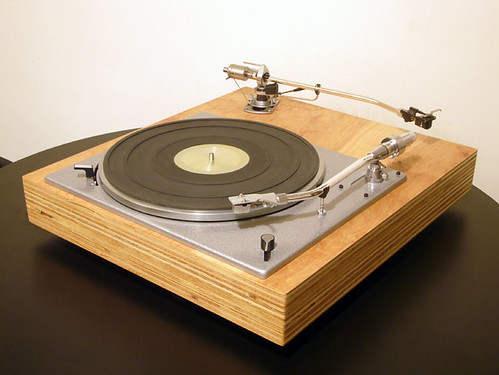£23.50 got me A Goldring Lenco GL75 which arrived Friday built into a Dynatron Music Centre:
Just quickly, Friday night, I ripped out the Dynatron amp, removed the transit screws, checked the motor was hanging freely, checked it was running at the correct speed, kept the plinth for now, fitted a spare Pro-Ject arm I had knocking about and fired it up.
This is what came out ... I suspect Dynatron gear must have been quite pricey at the time as it's very well put together - it also dates it to March 1972 - so 37 years old:
.
and this is what was left:

The original arm was completely shot - bent, knackered v blocks, serious rear end droop and basically good for nothing much. The Pro-Ject arm is near as damn it a drop in replacement. The mounting hole is a couple of mm larger than needed, but a ring of copper strip (my missus uses it to keep slugs off her pot plants) in the inside of the mount, and a bit of insulation tape on the column and it fits very snuggly. Geometry is spot on and with the Pro-Ject arm lift removed will go low enough for VTA to be spot on, utilising the original arm lift/lower mechanism. It will even go low enough to just use the standard mat and no spacers, but the counterweight rides a little low at the back. Not enough to affect play, but enough to touch the top plate if you lift the headshell end a little too far when cueing, so I added an achromat and raised the VTA 5mm. The antiskate loop is stuck to the plinth with insulating tape, and I refashioned an arm holder from the plastic arm holding piece on the Pro-Ject arm holder (it just pulls off) and an Allen key. So a bit of a lash up, but it works.

Initial impressions were of considerable bass extension, very good detail retrieval and a natural relaxed sound, but with a lot of get up and go. There was a fair bit of motor noise breaking through though.
Saturday. I stripped and relubed the bearing and stripped, relubed and rebuilt the motor.
There is some controversy about whether the bearing should be greased or oiled. The fact that the bearing cover is not watertight (as I discovered when I flushed it out and got IPA all over myself) suggests grease, however it also uses sintered bronze bushings further up the bearing, with a felt washer for soaking in oil at the top suggests oil. So I used both, grease at the bottom of the shaft where the ball is and a little oil on the bushings and the washer.
I also cleaned the underside of the platter and the idler (it came with one of the metal ones) with some alcohol, and oiled the ilder wheel bearing. And fired it up again. To be honest the motor noise didn't seem any less and the sound was harsh and bright. Touching the motor it vibrates noticably. I left it running overnight ... to a complete change ... the motor vibration has almost completely gone - and so has the harshness and the motor noise. The motor having been rebuilt seemed to need some bedding in. Just to be sure it wasn't a warming up thing, I left it a while to cool back down (it does get quite warm) and fired it up again, and it was fine, the vibrations much reduced. It definitely needed some bedding in.
I spent the rest of the day just playing records. This is an excellent deck. The thing that strikes you immediately next to the Spacedeck is the depth and speed of bass, but then you start noticing that there is a lot of textural detail that seemed missing before, and not just in the bass. Also the timing, speed stability and soundstaging is excellent. I'm a little shocked to be honest and this is on the thinnish original mounting board.
It'll be interesting to hear what happens with a proper plinth.
Oh and the platter was grey, pitted and old looking. Some brasso wadding and elbow grease sorted that out and the edge is now nice and shiny ... but the downside is a shiny platter is a lot less easy to get a grip on when you need to remove it.



